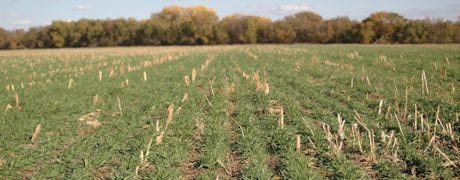
New research by a multistate team of agronomists working with the Midwest Cover Crops Council suggests that up to 19 million acres of corn and soybean ground in the upper Mississippi River Basin has the potential to incorporate cover crops, which would decrease nitrogen entering the Gulf of Mexico by up to 400 million pounds. At current prices, that nitrogen is valued at $160 million.

BIG BENEFIT: New research by Midwest Cover Crops Council says up to 19 million acres of corn and soybean ground in upper Mississippi River Basin has potential to use cover crops, and decrease nitrogen entering Gulf of Mexico by up to 400 million pounds. At current prices that's $160 million worth of N.
The research, published in the July-August 2014 issue of the "Journal of Soil and Water Conservation," looked at the potential to plant cover crops and the resulting decrease in nitrogen loss from farm fields in 10 counties spread across five states (Ohio, Indiana, Illinois, Iowa, Minnesota) as well as the Midwest region as a whole. The counties are located in watersheds that flow into the Mississippi River Basin and contribute to low oxygen zones that become incapable of supporting aquatic life in the Gulf of Mexico.
Expanding cover crops could have sizeable water quality benefit
"The potential for adopting cover crops in these critical watersheds is substantial, and cover crops should be considered as one of the primary conservation practices to improve water quality," says lead researcher Eileen Kladivko, an agronomy professor at Purdue University.
The researchers used data on available land, crop rotations and tillage systems in the areas studied to develop computer models that simulated the feasibility of planting cover crops. Potential water quality benefits were estimated for agricultural land with artificial drainage systems installed. The modeling scenarios looked at multiple cover crop species, but winter cereal rye was studied the most because of its comparatively widespread use: While adoption is less than 2%, it is the cover crop species most commonly planted by Midwestern row crop farmers.
Cover crops are worth pursuing, in spite of the challenges
Researchers say tillage practices and the challenge of planting covers during the fall harvest season—timing that is necessary to successfully seed and establish the cover crop—are two of the reasons why the cover crop adoption rate is low. "Cover crops are easier to integrate into no-till and strip-till systems," says Kladivko. "In contrast to a full-width tilled system, no-till and strip-till allow earlier planting in the fall and more time for cover crop growth in spring before terminating them with herbicides."
~~~PAGE_BREAK_HERE~~~
Tom Kaspar, scientist at USDA's National Laboratory for Ag and the Environment at Ames, Iowa, is co-author of the study. He says cover crops are worth pursuing in spite of these challenges because of the numerous benefits they offer. "We realize farmers have a lot on their plates and our estimates for potential cover crop use don't consider other factors like costs, labor and logistics," says Kaspar. "But, we all know we need to do a better job reducing nitrogen losses, and cover crops are one of the few practices that will do it, plus protect soil from erosion and improve soil health at the same time."
Planting 19 million acres of cover could save $160 million worth of N
Planting 19 million acres of cover could save $160 million worth of nitrogen from entering the Gulf of Mexico per year, notes Kaspar.
Other researchers involved in the study include soil scientist Dan Jaynes and ag engineer Robert Malone, both with the USDA-ARS lab in Ames; Jeremy Singer, former research agronomist at the USDA-ARS lab; Xenia Morin, associate dean in the School of Environmental and Biological Sciences at Rutgers University; and Tim Searchinger, researcher at Princeton University.
The researchers are all participants in the Midwest Cover Crops Council, a coalition of members in nine states and the Canadian province of Ontario. The MCCC's goal is to facilitate widespread adoption of cover crops throughout the Midwest to boost productivity of soil resources and improve the ecological, economic and social sustainability of farming systems.
About the Midwest Cover Crops Council: Founded in 2006 the Midwest Cover Crops Council is a diverse group including members from academia, non-government organizations, farmers, private sector and federal and state agencies seeking to significantly increase the amount of cover crops on the Midwest landscape. MCCC works toward this goal by sharing current research, identifying emerging priorities for regional collaboration, discussing challenges preventing broader adoption of cover crops, and exploring the possibility of partnerships. Practical Farmers is a participant in the MCCC. For more information visit www.mccc.msu.edu.
About the Author(s)
You May Also Like




